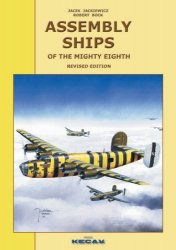The Eighth attacked aircraft factories and air bases in France and the Low Countries and at Watten, in France, smashed a huge bunker designed to house V'2 rockets; the concrete was still wet, and it was wrecked beyond repair. Some of its operations were part of an elaborate but unsuccessful attempt to make the Germans think the Allies intended to land in France, provoking an air battle. Bad weather delayed a return to Germany.
On September 6, three weeks after the Regensburg-Schweinfurt mission, 338 B'17s set out for the SKF ball bearings plant at Stuttgart, while B-24s flew a diversion over the North Sea. Poorly planned and conducted, the mission failed. Over France the force hit such heavy cloud that it should have turned back. Only one wing saw the target; some units overshot, while others used up fuel circling and seeking a hole in the clouds, which inhibited bombing but not the German fighters. Between German attacks and lack of fuel, 45 went down and 10 were written off after landing. Of the B'17s that were lost, 12 managed to ditch, and Air Sea Rescue pulled 118 of their men out of the sea, which prevented a disaster not far short of the Regensburg-Schweinfurt mission. Some men were more shaken by the waste and bungling over Stuttgart than by the earlier and more famous battle.®
During September Vlllth Bomber Command was reorganized. The old 1st Bombardment Wing became the 1st Bombardment Division and the B-24 units became the 2nd Bombardment Division, while the old 4th Wing became the 3rd Bombardment Division. Each Fortress division was subdivided into three newly formed combat bomb wings, each of which, when enough units arrived, would consist of three groups. The Eighth Air Force received much new equipment. It began getting the new B-17G, the ultimate Flying Fortress. Most important of its many improvements was a remote-controlled “chin” turret under the nose, to deal with head-on attacks. (Chin turrets were also installed on B-17Fs that were used as “lead ships.”) The B-17G’s waist positions were staggered and enclosed with Plexiglas panels, making life easier for the waist gunners, who all too often had been freezing and without room to work. Later B-17Gs had a Cheyenne tail turret, powered and with better sights. But few, if any, now thought that any improvement would enable the bombers to defend themselves.
In August and September the Eighth received fighter reinforcements. Drop-tanks, though too few were available, were extending the fighter’s range. But escort was still limited to northwestern Germany. Two of the five new fighter groups had P'38H fighters whose range theoretically allowed escort out to 450 miles, but they lacked enough planes, and equipment problems meant that the 55th Group did not become operational until October 15. The 20th Group was not ready until the end of 1943! It was already suspected that the P-38, due to its lack of acceleration and other problems not yet fully known, was not really the solution to the escort problem.
The Eighth found a partial solution to another problem, bad weather, which often prevented successful visual attacks on Germany and did so in all of September. Experiments with bombing on Gee had not worked; the Americans borrowed H2S equipment from the British while developing their own version, H2X. A pathfinder group was formed to use both systems; its bombers would lead other formations. On September 27 the American pathfinders led their first operation against Emden; this was also the first mission to a German target that was escorted all the way. The target area was an important port, giving a good H2S picture. Two forces, comprising 305 B'17s, were sent out, each led by two H2S planes. The lead wings bombed on signals from the Pathfinder planes, which dropped smoke markers to guide the following wings. The results were mixed; half the H2S sets failed, and the markers vanished before the last wings of each force could bomb. Another attempt on Emden would be made on October 2.
The wings that bombed on signal had achieved a circular error of half a mile to a mile, but dropping on markers had been wildly inaccurate, producing an average error of over five miles. More and better radar was needed, but even with it, this sort of bombing would be no more than a poor way to keep up the pressure on Germany when visual bombing was impossible. Crewmen referred to such attacks as “women and children’s day.”
Strangely, the Eighth Air Force made little use of Oboe. In early 1943 the British did not want it risked over Germany in planes that were a lot more likely to be shot down than Mosquitos. Later experiments were plagued by equipment failure, while the limited range of Oboe probably discouraged more effort to make it work. Even in late 1944, with more and better equipment and far more experience, over half the radar missions failed. One advantage of such missions, however, was that the Germans were reluctant to send their pilots, who now were not usually instrument trained, through solid overcast. They eventually formed two special “bad weather units,” Jagdgeschwader 300 and 301, of pilots who could be trusted in such conditions.®




 World History
World History









